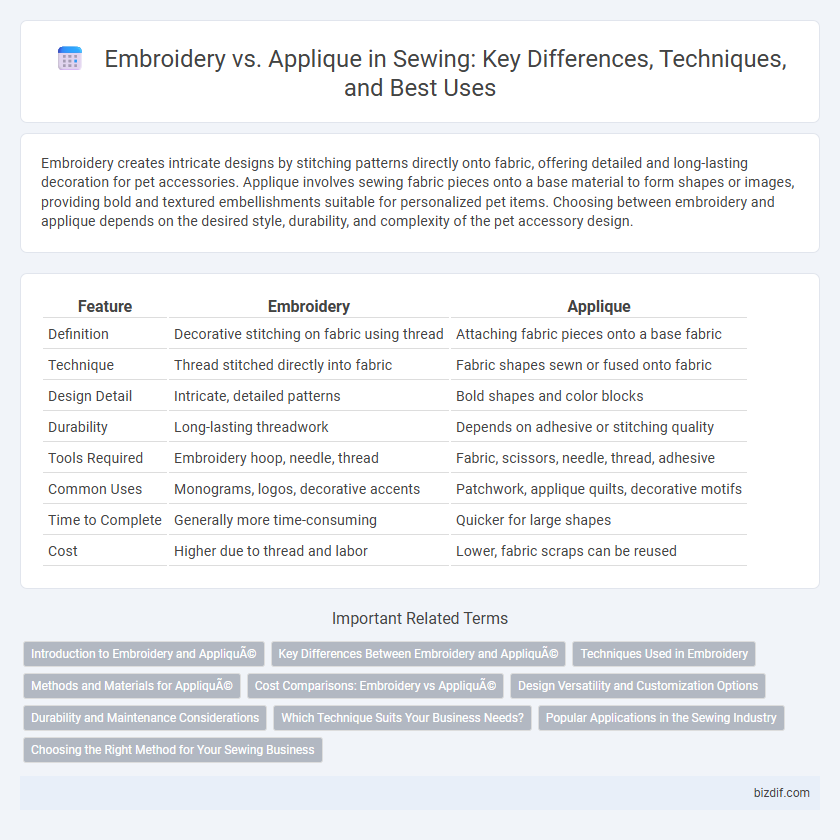Embroidery creates intricate designs by stitching patterns directly onto fabric, offering detailed and long-lasting decoration for pet accessories. Applique involves sewing fabric pieces onto a base material to form shapes or images, providing bold and textured embellishments suitable for personalized pet items. Choosing between embroidery and applique depends on the desired style, durability, and complexity of the pet accessory design.
Table of Comparison
| Feature | Embroidery | Applique |
|---|---|---|
| Definition | Decorative stitching on fabric using thread | Attaching fabric pieces onto a base fabric |
| Technique | Thread stitched directly into fabric | Fabric shapes sewn or fused onto fabric |
| Design Detail | Intricate, detailed patterns | Bold shapes and color blocks |
| Durability | Long-lasting threadwork | Depends on adhesive or stitching quality |
| Tools Required | Embroidery hoop, needle, thread | Fabric, scissors, needle, thread, adhesive |
| Common Uses | Monograms, logos, decorative accents | Patchwork, applique quilts, decorative motifs |
| Time to Complete | Generally more time-consuming | Quicker for large shapes |
| Cost | Higher due to thread and labor | Lower, fabric scraps can be reused |
Introduction to Embroidery and Appliqué
Embroidery is a decorative sewing technique that involves stitching patterns onto fabric using threads of various colors and textures, enhancing the design's detail and dimension. Applique involves sewing fabric pieces onto a larger fabric base, creating intricate patterns or images by layering materials and stitching them securely. Both techniques add visual interest and texture to garments or textiles, each offering distinct artistic effects and customization options.
Key Differences Between Embroidery and Appliqué
Embroidery involves stitching patterns directly onto fabric using various types of thread, creating detailed and textured designs, whereas applique entails sewing pieces of fabric onto a base fabric to form decorative motifs with contrasting textures and colors. Embroidery allows for fine, intricate designs with thread-based shading, while applique focuses on fabric layering to achieve bold shapes and patterns. The key difference lies in embroidery's thread-centric detail work versus applique's fabric-focused assembly.
Techniques Used in Embroidery
Embroidery techniques involve stitching patterns directly onto fabric using methods such as satin stitch, cross-stitch, and bullion knots, allowing for intricate and textured designs. These techniques utilize various threads, including cotton, silk, and metallic, to create detailed motifs and decorative effects. Mastery of embroidery stitches requires precision and control to achieve uniform tension and enhance the overall aesthetic of the textile.
Methods and Materials for Appliqué
Applique involves layering fabric pieces onto a base material, secured through techniques like hand stitching, machine stitching, or fusible bonding using heat-activated adhesive. Common materials for applique include cotton, felt, silk, and denim, chosen for their durability and ease of handling. Stabilizers such as tear-away or cut-away are essential to maintain fabric shape and prevent puckering during the sewing process.
Cost Comparisons: Embroidery vs Appliqué
Embroidery typically incurs higher costs due to detailed stitching and thread usage, while applique often reduces expenses by incorporating fabric pieces, minimizing thread consumption. Machine embroidery requires costly digitizing and thread, whereas applique involves less machine time but additional fabric materials that can affect overall price. For large-scale projects, applique tends to offer better cost-efficiency, whereas embroidery provides intricate, durable designs at a premium.
Design Versatility and Customization Options
Embroidery offers intricate detail and texture through stitched patterns, ideal for precise monograms and logos, while applique provides vibrant design versatility by layering fabric shapes for bold, textured looks. Customization in embroidery includes thread color blends and stitch density variations, enhancing subtlety and depth, whereas applique allows for mixing fabrics, patterns, and embellishments that create standout visual effects. Selecting between embroidery and applique depends on the desired design complexity and the textile's compatibility with stitching or fabric layering techniques.
Durability and Maintenance Considerations
Embroidery offers superior durability as the stitched designs are integrated directly into the fabric, making them resistant to wear and frequent washing. Applique, while visually striking, involves fabric pieces sewn onto the base fabric, which may require gentle handling and careful washing to prevent fraying or lifting. For long-lasting projects, embroidery requires minimal maintenance, whereas applique demands more attentive care to preserve its appearance over time.
Which Technique Suits Your Business Needs?
Embroidery offers a detailed, durable finish ideal for branding and high-quality logos on apparel, making it perfect for businesses seeking long-lasting, professional designs. Applique provides vibrant texture and unique layered effects, suitable for creative, bold statements or decorative patterns on varied fabric types. Choosing between embroidery and applique depends on your business's design complexity, fabric compatibility, and desired visual impact for product differentiation.
Popular Applications in the Sewing Industry
Embroidery is widely used in the sewing industry for creating detailed logos, monograms, and decorative patterns on garments, uniforms, and home textiles, offering durability and precision. Applique is favored for adding textured patches and contrasting fabric designs to quilts, children's clothing, and accessories, providing a bold, dimensional effect. Both techniques enhance product appeal, with embroidery excelling in fine detail work and applique delivering vibrant fabric contrasts.
Choosing the Right Method for Your Sewing Business
Embroidery offers intricate designs with durable stitching ideal for branding and adding detailed logos, while applique provides textured, layered fabric art perfect for bold, eye-catching patterns. Selecting the right method depends on your target market, production volume, and garment type, as embroidery suits professional, polished finishes and applique excels in creative, bespoke styles. Understanding fabric compatibility and cost implications ensures efficient workflow and customer satisfaction in your sewing business.
Embroidery vs Appliqué Infographic

 bizdif.com
bizdif.com